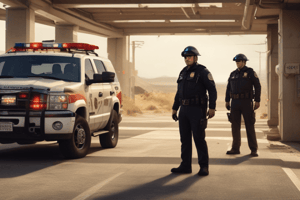Podcast
Questions and Answers
What is the primary responsibility of the Fire Marshal's Office regarding the Knox Box System?
What is the primary responsibility of the Fire Marshal's Office regarding the Knox Box System?
- To oversee the sale of Knox Box devices.
- To install Knox Boxes at various locations.
- To handle administrative duties for procuring Knox Boxes. (correct)
- To train fire department personnel on using Knox Boxes.
Where should the height of the Knox Box typically be installed?
Where should the height of the Knox Box typically be installed?
- Above 10 feet to ensure visibility.
- At the roof level for easier access.
- Between 5 and 8 feet above grade. (correct)
- At or below 3 feet from the ground.
What action should the owner/agent take after receiving the Knox Box device?
What action should the owner/agent take after receiving the Knox Box device?
- Immediately lock the box on their own.
- Conduct a safety drill with it.
- Start using the box without any consultation.
- Contact the Fire Marshal's Office for guidance. (correct)
Which personnel are responsible for scheduling a site visit after a Knox Box is received?
Which personnel are responsible for scheduling a site visit after a Knox Box is received?
What must be submitted to the Fire Marshal’s Office after a station locks the Knox Box?
What must be submitted to the Fire Marshal’s Office after a station locks the Knox Box?
What is a recommended consideration for proper placement of the Knox Box?
What is a recommended consideration for proper placement of the Knox Box?
What type of facilities specifically require accessibility by medic units for Knox Box installation?
What type of facilities specifically require accessibility by medic units for Knox Box installation?
What must the owner/agent do to ensure that the Knox Box is secured post-installation?
What must the owner/agent do to ensure that the Knox Box is secured post-installation?
What is required of the Division/Battalion Commander during the annual inventory of Knox Box Keys?
What is required of the Division/Battalion Commander during the annual inventory of Knox Box Keys?
What action should be taken if a Knox Box key does not work properly?
What action should be taken if a Knox Box key does not work properly?
How often are the inspections of Knox Box keys required for Volunteer stations?
How often are the inspections of Knox Box keys required for Volunteer stations?
Who is responsible for performing weekly checks of Knox Box keys?
Who is responsible for performing weekly checks of Knox Box keys?
What should happen if missing keys are identified during the annual inventory?
What should happen if missing keys are identified during the annual inventory?
What is the timing for verifying the log book and Knox Box keys for volunteer equipment?
What is the timing for verifying the log book and Knox Box keys for volunteer equipment?
What consequence does a lack of accountability for missing keys hold for station commanders?
What consequence does a lack of accountability for missing keys hold for station commanders?
What is one responsibility of the Vice-President of Operations following the bi-annual inspections?
What is one responsibility of the Vice-President of Operations following the bi-annual inspections?
What is the primary action required after the owner/agent receives the Knox Box device?
What is the primary action required after the owner/agent receives the Knox Box device?
What should the Fire Marshal’s Office do upon receipt of the Knox Box Inspection Form?
What should the Fire Marshal’s Office do upon receipt of the Knox Box Inspection Form?
Who is responsible for ensuring personnel are aware of Knox Box locations within their district?
Who is responsible for ensuring personnel are aware of Knox Box locations within their district?
What is the purpose of the Knox Box Inspection Form during annual inspections?
What is the purpose of the Knox Box Inspection Form during annual inspections?
What should a Company Commander do if forced entry is made at a location with a Knox Box?
What should a Company Commander do if forced entry is made at a location with a Knox Box?
How often should Knox Box annual routine inspections be performed?
How often should Knox Box annual routine inspections be performed?
What is indicated about Knox Box emblems?
What is indicated about Knox Box emblems?
What is the procedure if repairs are needed after testing a Knox Box?
What is the procedure if repairs are needed after testing a Knox Box?
What must be done with the white copy of the Knox Box Inspection Form after completing the necessary steps?
What must be done with the white copy of the Knox Box Inspection Form after completing the necessary steps?
What must be checked daily by the Officer-in-Charge regarding the Knox Box keys?
What must be checked daily by the Officer-in-Charge regarding the Knox Box keys?
Flashcards are hidden until you start studying
Study Notes
Knox Box Entry System Overview
- Establishes guidelines for non-destructive entry systems in emergency operations.
- Ensures accountability and security of Knox Box keys in Baltimore County jurisdiction.
Procurement Procedures
- Fire Marshal's Office manages Knox Box procurement and provides necessary information to interested parties.
- Knox Box can be sold only with authorization from the Fire Marshal's office.
- Installation involves guidance from the first due career company.
Knox Box Installation Guidelines
- Placement recommendations: 5 to 8 feet above grade, accessible for emergency vehicles, and consideration for equipment height.
- Buildings must display Knox Box stickers on accessible entry points.
- After installation, the owner/agent must ensure the Knox Box is locked and report to the Fire Marshal’s Office.
Inventory and Tracking
- Keys placed in the Knox Box must be recorded using the Knox Box Inspection Form.
- Responsibility to ensure keys are listed accurately in the FS-01 system by the responding station.
- Reports and forms must be submitted to the Fire Marshal’s Office for tracking.
Emergency Response Protocols
- Company commanders must familiarize personnel with Knox Box locations in their districts.
- Emphasizes non-destructive entry to minimize property damage during emergencies.
- Mandates reporting procedures for forced entries even with Knox Box presence.
Annual Inspections
- First due career companies are responsible for annual routine inspections of Knox Boxes.
- Inspections should align with facility examinations when possible.
- Key inventory during inspections is essential; results must be documented for the FS-01 system.
Knox Box Identification
- Knox Box emblems should be visibly displayed at main and secondary entrances of buildings.
- Requests for additional emblems can be made through the Fire Marshal's Office.
Daily and Annual Key Checks
- Officers in charge must inventory Knox Box keys at each shift change, documenting any missing keys.
- Division/Battalion Commanders conduct annual key inventories and investigations into missing keys.
- Accountability for missing keys is a critical responsibility; neglect warrants severe consequences.
Key Management for Volunteer Stations
- Volunteer stations receive signed Knox Box keys from senior Fire-Line officers.
- Bi-annual inspections are mandated to maintain key accountability.
- Weekly inspections and logs are required to ensure ongoing access and accountability.
Miscellaneous
- All Knox Box systems in Baltimore County are uniquely keyed to their devices; issues with key compatibility must be reported.
- Emergency communication related to Knox Box installations is channeled through the Fire Marshal’s Office only.
Studying That Suits You
Use AI to generate personalized quizzes and flashcards to suit your learning preferences.




